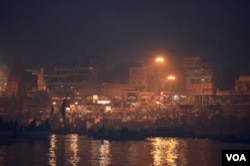In Kanpur, a busy industrial city in eastern India, environmental activist Rakesh Jaiswal has waged a quarter-century long campaign to stop the flow of poisonous chemical waste from the city’s thriving leather industry into the Ganges River.
The “Eco Friends” voluntary group he heads was launched after he watched the waters of one of the world’s mighty rivers turn into a toxic cocktail as crowded cities along its banks dump millions of tons of untreated sewage and industrial waste, bodies, animal carcasses and non-degradable waste.
“The water is stinking, it is black, it is muddy, especially in the areas where tanneries are situated. The river is dead there,” bemoans Jaiswal.
As the government launches an ambitious $3 billion plan to rejuvenate the 2,500 kilometer long Ganges, the green campaigner swings between optimism and despair.
“Now new hope has been ignited by this government. But if I go by the experience, I have lost hope,” he said.
Hope and despair
He has reason to be skeptical. Over the last three decades, high profile programs costing millions of dollars to clean up the river that Hindus consider holy have not only been unsuccessful, but the pollution has worsened.
This time, Prime Minister Narendra Modi has vowed it will be different. Rejuvenating the river known as mother, or “Ma Ganga,” is one of the pledges close to the heart of the Hindu nationalist leader.
Experts say the situation is grim, particularly along the stretch where populous cities like Kanpur, Varanasi and Allahabad have sprung up on its banks. As it gushes down from the snow-covered slopes of the Himalayas and journeys through the plains of North India, the Ganges supports an estimated 400 million people.
“From Narora to Allahabad, along 600 kilometers, Ganga water has probably more than 75 percent city sewage and urban effluents and hardly 20 to 25 percent fresh water,” said R.K. Sinha, a zoology professor at Patna University, who has spearheaded efforts to save the Ganges river dolphin from extinction.
He said the flow of the river has been reduced drastically in the plains. A large part of this stretch lies in two states, Uttar Pradesh and Bihar, where governance is poor.
Launching the project called “Namami Ganga,” Water Resources Minister Uma Bharti said the federal government will address all sources of pollution. “Work is beginning at 100 places simultaneously to plant trees, do riverside development, build plants to treat sewage industrial effluents,” she said last week, promising quick results.
Holy waters
Perhaps the most closely-watched stretch will be along the holy city of Varanasi, the Prime Minister’s constituency. It is here that millions of Hindu devotees come to perform the last rites of their loved ones and take a dip in the river, believing it will wash away past sins. Many take a sip of the water, considered as nectar.
But is the water safe to drink or bathe along Varanasi’s famous banks where a colorful religious ceremony is held every evening? Experts answer with an emphatic “no.”
“In Varanasi, the present situation is very alarming,” said Vishwambhar Nath Mishra, a professor at the reputed Indian Institute of Technology in the city.
He points out that the technology being used in sewer plants set up earlier did not fully remove the bacteria from the sewage. He worries that in the new plans also, not enough attention has been paid to engineering solutions. “The technology they are using, I think they are sailing still in same boat,” he said.
Mishra, who is also a priest and an environmental campaigner, heads the Sankat Mochan Foundation, which has worked with the local corporation and been involved with earlier projects to revive the Ganges.
He said the main focus should be to ensure that not a drop of sewage is dumped into the river. “Whatever sewage you are generating in the city should be treated and it should be reused for farming and any other thing, and if they don’t have that capability of reusing, they can discharge it downstream,” said Mishra.
Strict oversight
Others point out that it will not be easy to prod India’s slow-moving bureaucracy and lethargic state governments, which often miss project deadlines although the federal government has promised strict oversight.
Saying that implementation will be the main challenge, Jaiswal in Kanpur hopes the government will learn from the failures of the past. “Rs 700 crores (approximately 100 million dollars) were spent in order to sewer the entire Kanpur city and also set up sewage treatment plants. But all these plans were left halfway,” he said.
There are some milestones to cheer, largely due to the efforts of voluntary groups and green activists living in cities that have watched the degradation of Ganges. In Kanpur, after Eco Friends helped raise public awareness, people have stopped dumping bodies and animal carcasses into the river. Thousands of bodies have been removed from the river. There are programs to enroll school children as “Ganga Ambassadors” so that a new generation will be more sensitized to combating river pollution.
The endangered Ganga dolphin still swims in the river’s waters, after awareness was raised about protecting its habitat, and laws against its killing were tightened.
And in Varanasi, Mishra remains steadfast in his zeal to see a clean, flowing river in the holy city, a passion he inherited from his father. “I would love to hear that this will happen in my lifetime. If not, my next generation will take up the issue. It’s like a relay race, but we are not going to give up”, vowed Mishra.
And more than all, the ambitious Ganga project will test the reputation of Modi as a leader who repeatedly asserts that his government, unlike previous ones, can deliver on its promises.






